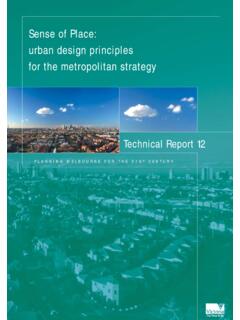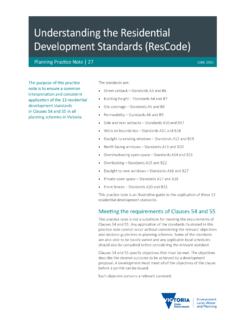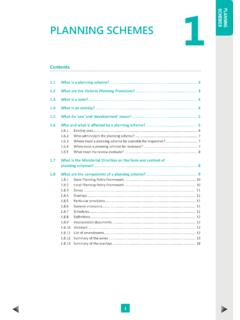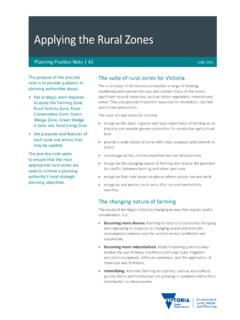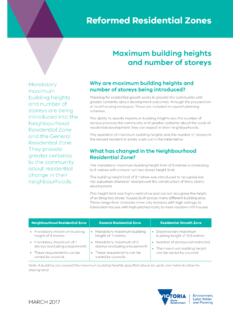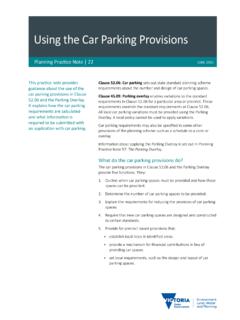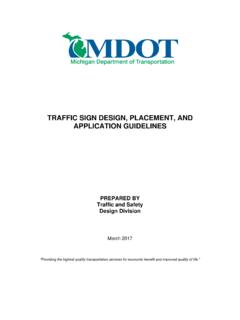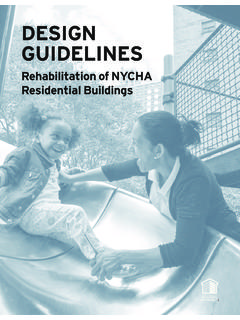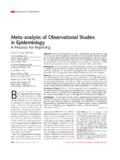Transcription of Apartment Design Guidelines for Victoria - Planning
1 Apartment Design Guidelines for Victoria The State of Victoria Department of Environment, Land, Water & Planning 2017 This work is licensed under a Creative Commons Attribution International licence. You are free to re-use the work under that licence, on the condition that you credit the State of Victoria as author. The licence does not apply to any images, photographs or branding, including the Victorian Coat of Arms, the Victorian Government logo and the Department of Environment, Land, Water and Planning (DELWP) logo. To view a copy of this licence, visit 978-1-76047-573-4 (pdf/online) Accessibility If you would like to receive this publication in an alternative format, please telephone the DELWP Customer Service Centre on 136186, email or via the National Relay Service on 133 677 This document is also available on the internet at publication may be of assistance to you but the State of Victoria and its employees do not guarantee that the publication is without flaw of any kind or is wholly appropriate for your particular purposes and therefore disclaims all liability for any error, loss or other consequence which may arise from you relying on any information in this : Collins and Queen (Rothelowman).
2 Photography by Scott Design Guidelines for Victoria3 ContentsIntroduction 4 Structure of the Guidelines 5 Application of the Apartment standards 6 Urban context and Design response 7 Section 1 | SITING AND BUILDING ARRANGEMENT 11 Guidance to building setback 11 Guidance to communal open space 20 Guidance to solar access to communal outdoor open space 24 Guidance to landscaping 26 Guidance to building entry and circulation 34 Section 2 | BUILDING PERFORMANCE 38 Guidance to noise impacts 38 Guidance to energy efficiency 44 Guidance to waste and recycling 47 Guidance to integrated water and stormwater management 51 Section 3 | DWELLING AMENITY 54 Guidance to functional layout 54 Guidance to room depth 57 Guidance to windows 60 Guidance to storage 63 Guidance to natural ventilation 66 Guidance to private open space 69 Guidance to accessibility 73 Glossary 77 4 Apartment Design Guidelines for VictoriaThe Victorian Government is committed to ensuring that apartments deliver diverse and affordable housing options to meet the long-term needs of the Victorian community.
3 There is a need to lift the quality and functionality of apartments to benefit the health and well-being of residents, and improve environmental performance. Improving Apartment designThe Apartment Standards (Standards) are intended to improve Apartment Design in Victoria . The Design of Apartment buildings that suitably responds to context and successfully incorporates the Apartment standards and Guidelines requires specialist Design capabilities. It is important for the success of the project to select a team of Design professionals to be led by an experienced architect or building designer who can analyse and integrate the multiple requirements into a successful Design that contributes positively to the urban context and the neighbourhood character. Alternative Design solutions may be proposed and the responsible authority will assess how an alternative solution meets the objectives. This is an important aspect of innovation. Purpose of the guidelinesThe Apartment Design Guidelines for Victoria provide assistance to applicants, architects, building designers and planners for designing and assessing Apartment developments.
4 The Guidelines provide additional explanation of the Apartment standards in the Interpreting the Standards section and guidance on matters to consider to meet the objectives of the Apartment standards in the Design Guidance section. The Guidelines are also intended to support greater consistency in the Planning permit assessment phase of an Apartment development. The Guidelines are complemented by the Urban Design Guidelines for Victoria which provide best practice knowledge and advice to inform the Design of buildings in relation to the function and amenity of the public realm. IntroductionApartment Design Guidelines for Victoria5 The Apartment Design Guidelines for Victoria are arranged in three sections as follows. All three sections and their elements are interrelated and require an integrated approach to achieve the objectives. For ease of reference, each section includes the standards, objectives and decision Guidelines for each standard.
5 The Guidelines include further interpretation where required, and suggestions for how the objectives can be 1. SITING AND BUILDING ARRANGEMENTThis section reinforces the importance of urban context report and Design response as a starting point for Design and considers Standards primarily related to the Design and configuration of buildings at a site scale. This involves assessing the immediate context, adjacent buildings and public realm. The Guidelines relate to how the building envelope (its three dimensional volume) is established through applying appropriate building types, orientation and setbacks. Siting the building also establishes where communal open space is located, how landscape is incorporated into the proposal and how entries and shared circulation is arranged. This section includes the following standards:1. Building setback2. Communal open space3. Solar access to communal outdoor open space4. Landscaping5. Building entry and circulationSection 2.
6 BUILDING PERFORMANCE This section provides guidance about performance issues which need to be considered in designing the building such as noise impacts, energy performance and management of water and waste. These issues require consideration at both a site scale and at a more detailed building systems level. These Standards relate closely to other environmental assessment tools and typically require specialist input to support the Design response. This section includes the following Standards:6. Noise impacts7. Energy efficiency8. Waste and recycling9. Integrated water and stormwater managementSection 3. DWELLING AMENITY This section introduces guidance related to the detailed Design of individual dwellings. The Guidelines address amenity issues such as access to daylight and ventilation through arrangements of windows and room depth as well as functional and accessible layouts of internal and external space. This section includes the following standards:10.
7 Functional layout11. Room depth12. Windows13. Storage14. Natural ventilation15. Private open space16. Accessibility Structure of the Guidelines6 Apartment Design Guidelines for VictoriaThe Standards apply to all Apartment developments in Victoria . The Standards have been introduced to the Victoria Planning Provisions and all Planning schemes in: A new clause in Clause 55 (Two or more dwellings on a lot and Residential buildings) at Clause , and A new Particular Provision at Clause 58 (Apartments). Apartment developments of four storeys or less (excluding a basement) in a residential zone will continue to be assessed against most of the standards under Clause 55 (which includes new Apartment Standards at Clause 57). Apartment developments of five or more storeys (excluding a basement) in a residential zone and all Apartment developments in other zones will be assessed against Clause 58. The Guidelines relate to both the new Clause 58 provisions and the new Clause provisions.
8 Refer to Planning Advisory Note 66: New Planning provisions for Apartment developments Amendment VC136 (April 2017) for details of how the new standards for Apartment developments are given effect in both the amended Clause 55 and new Clause of the Apartment standardsThe Apartment provisions operate in the same way that Clauses 54 and 55 operate to assess residential development in the Victoria Planning Provisions. The Apartment provisions contain Objectives, Standards and Decision Guidelines . Objectives describe the desired outcomes to be achieved in the completed development. A Standard contains the requirements to meet the objective. A standard should normally be met. However, if the responsible authority is satisfied that an alternative Design solution meets the objective, the alternative Design solution may be considered. Decision Guidelines set out the matters that the responsible authority must consider before deciding if an application meets the objectives.
9 When an alternative Design solution is proposed, the effect of the Design solution on the achievement of other objectives should be Apartment development: Must meet of the objectives of Clause 55 or Clause 58. Should meet the standards of Clause 55 or Clause Apartment standards contained in Clause cannot be varied in a schedule to the zone. A select number of the existing standards under Clause 55 continue to have the ability to be varied by schedules to the Neighbourhood Character Overlay will continue to allow variations to most of the standards of Clause 55 except for the Apartment standards in Clause and existing key amenity standards such as overshadowing and daylight to new and existing standards in Clause 58 cannot be varied in a schedule to the zone or an overlay, except for the Building setback standard (Clause ).Application of the Apartment standardsApartment Design Guidelines for Victoria7 Urban context and Design responseNeighbourhood and site description and Design responseFor Apartment developments of four storeys or less (excluding a basement) in a residential zone, the Victoria Planning Provisions in Clause requires a Neighbourhood and site description and Design response to be prepared and submitted with an application.
10 A neighbourhood site description accurately describes the features or characteristics of the neighbourhood and the site. A neighbourhood and site description is a factual record of the physical features of the neighbourhood and the site. Therefore, the description should be impartial and describe both the positive and negative features of the neighbourhood and the site. A Design response must explain how the proposed Design : derives from and responds to the neighbourhood and site description. It involves evaluating the influence that features identified in the description should have on the Design meets the objectives of Clause 55 responds to any neighbourhood character features for the area identified in a local Planning policy or a Neighbourhood Character more information on preparing a neighbourhood and site description and Design response refer to the following documents available on the department s website: Planning Practice Note 16: Making a Planning application for one or more dwellings in a Residential zone Planning Practice Note 43: Understanding Neighbourhood context report and Design responseFor Apartment developments of five or more storeys (excluding a basement) in a residential zone and all Apartment developments in other zones, the Victoria Planning Provisions in Clause requires a Urban context report and Design response to be prepared and submitted with an application.

